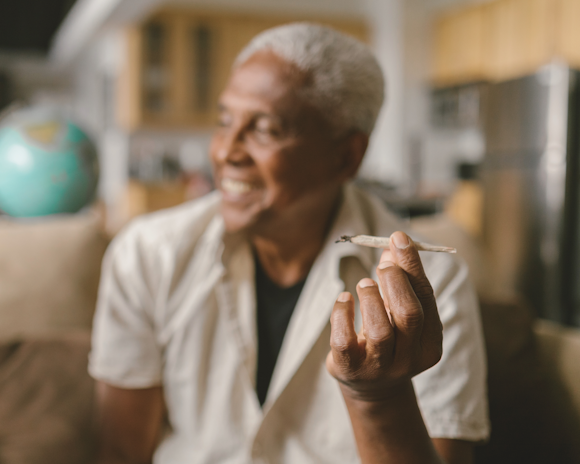
19 Cannabis Arthritis Pain Statistics in 2025
Comprehensive data compiled from extensive research on cannabis for arthritis pain management
Key Takeaways
- You’re not alone in seeking alternatives – 18.4% of arthritis patients now use cannabis for pain relief, with 83% reporting meaningful improvements in their symptoms
- Your pain reduction is real and measurable – Clinical studies show 2.3 pain score reductions
- The type of cannabis matters significantly – THC-containing products show 62% effectiveness versus just 39% for CBD-only formulations
- Medication reduction is possible and common – 60.5% of cannabis users successfully reduce or discontinue other medications, including 18.9% who completely stop opioids
- Cost barriers are valid but changing – While insurance doesn’t cover the monthly cannabis costs, you may save a lot of money compared to annual biologics
- Healthcare providers are catching up slowly – Though 80% of rheumatologists get weekly cannabis questions, only 38.7% feel comfortable recommending it
- Persistence challenges are real but manageable – While 57.9% discontinue within a year, those who find the right formulation report sustained 12-month benefits
- Every patient’s journey is unique – Whether you’re among the 35% daily users or 23% occasional users, personalized approaches yield the best outcomes
Understanding the Scope
1. 18.4% of rheumatic disease patients use cannabis for pain relief
From 6.3% in 2014, cannabis use for rheumatic diseases increased to 18.4% in 2019. This represents millions of Americans seeking alternatives to traditional medications. If you’re considering or using cannabis for arthritis, you’re joining a substantial and growing community of patients taking control of their pain management. The prevalence is even higher in states with recreational programs, reaching 8.3% versus 3.3% in medical-only states. Source: PubMed – Cannabis Use for Rheumatic Diseases
2. Cannabis-using arthritis patients report about 2.3 decrease in pain levels
Recent patient surveys in inflammatory arthritis report mean pain score drops from 6.16 to 3.89 points on a 0–10 scale. These improvements span pain reduction, better sleep, enhanced mobility, and improved quality of life. If you’ve found relief with cannabis, you’re part of the vast majority who experience benefits. This high success rate explains why patient demand continues growing despite limited physician support. Source: NORML Study on Arthritis Improvements
3. 53 million U.S. adults have doctor-diagnosed arthritis
Arthritis affects approximately 21.5% of all U.S. adults, with higher rates among women (21.5%) than men (16.1%). This massive population faces daily pain management decisions, with traditional treatments often providing inadequate relief. If you’re among these millions, exploring all available options including cannabis becomes increasingly important for maintaining quality of life. The CDC projects these numbers will continue rising as the population ages. Source: CDC Arthritis Statistics
4. 38 states plus DC now allow medical cannabis for arthritis
Legal access to medical cannabis covers 73% of the U.S. population, with arthritis qualifying as a condition in most programs. However, arthritis represents only 3.9% of primary conditions among 2.9 million registered patients, suggesting many eligible patients haven’t yet enrolled. If you live in a legal state but haven’t explored medical cannabis, you may be missing an accessible treatment option. State programs continue expanding, with new qualifying conditions added regularly. Source: PubMed Central – Medical Cannabis Programs
Effectiveness & Pain Relief
5. THC products show 62% effectiveness vs 39% for CBD-only
The cannabinoid type makes a dramatic difference in outcomes, with THC-containing products nearly doubling CBD’s effectiveness rate. Many patients start with CBD due to legal concerns or stigma, potentially missing better relief. If CBD hasn’t worked for you, adding THC might be the missing component for effective pain management. This data comes from American College of Rheumatology patient surveys tracking real-world outcomes. Source: ACR Meeting Abstracts
6. 66% achieve better sleep quality and physical function
Beyond pain relief, two-thirds of cannabis users report improvements in sleep and daily activities according to UK Medical Cannabis Registry data. Sleep quality particularly impacts arthritis symptoms, creating positive cycles of improvement. If you’re struggling with arthritis-related insomnia, cannabis may address both pain and sleep simultaneously. These improvements sustained at 1, 3, 6, and 12-month checkpoints. Source: UK Medical Cannabis Registry via NORML
7. High-dose CBD alone (600mg) shows no benefit over placebo
A landmark 2023 Lancet RCT found pure CBD at extremely high doses provided no meaningful benefit for knee osteoarthritis. This disappointing result highlights why many patients need THC for therapeutic effects. If you’ve tried CBD products without success, the science supports your experience – CBD alone may be insufficient for arthritis pain. Similar failures occurred in hand osteoarthritis trials, reinforcing THC’s importance. Source: The Lancet Regional Health Europe
Medication Reduction & Safety
8. 60.5% reduce or discontinue other medications
A CBD-user survey shows that more than half of cannabis users successfully decrease their pharmaceutical burden, improving quality of life and reducing side effects. This includes 31.1% reducing anti-inflammatories and 18.2% decreasing acetaminophen use. If you’re concerned about long-term NSAID or opioid use, cannabis offers a potential exit strategy. The medication reduction effect appears strongest in younger patients under 50. Source: Journal of Cannabis Research
9. 18.9% completely discontinue opioid medications
Nearly one in five CBD users successfully eliminates opioid dependence entirely, addressing the crisis of chronic pain opioid use. This represents thousands avoiding addiction risks and regaining control over their treatment. If you’re trapped in opioid dependency for arthritis pain, cannabis provides a proven pathway to freedom. Long-term studies show these reductions are sustained over 12+ months. Source: PubMed CBD Study
10. 84% of cannabis side effects rated as mild
Safety profiles strongly favor cannabis over traditional arthritis medications, with most adverse effects being manageable and temporary. Common side effects include dry mouth (20%), drowsiness (17%), and appetite changes (9%) – far less serious than NSAID bleeding risks or biologic infections. If you’ve struggled with medication side effects, cannabis offers a gentler alternative for most patients. Serious adverse events remain rare at less than 3% of users. Source: Journal of Cannabis Research
11. Cannabis users show 63% lower in-hospital mortality
Hospitalized rheumatoid arthritis patients using cannabis had mortality rates of just 0.98% versus 2.71% for non-users. This dramatic difference suggests systemic health benefits beyond pain relief. If you’re managing severe arthritis, cannabis use correlates with better overall outcomes during health crises. Hospital charges also averaged $6,000 less for cannabis users. Source: PubMed Central – RA Inpatient Outcomes
Patient Demographics & Usage Patterns
12. Cannabis users average 16 years younger (51.8 vs 67.8)
The generational divide in cannabis acceptance creates a striking age gap among users, with younger patients more willing to try alternative treatments. This doesn’t mean cannabis doesn’t work for older adults – rather, stigma and unfamiliarity create barriers. If you’re over 65 and considering cannabis, know that age doesn’t predict treatment success, only initial willingness to try. Source: PubMed Central – RA Patient Demographics
13. African Americans represent 24% of cannabis users vs 13% of non-users
Racial disparities in cannabis adoption reflect both cultural acceptance and inadequate pain management in minority communities. Black arthritis patients are nearly twice as likely to use cannabis, potentially due to healthcare access barriers for traditional treatments. If you’re a minority patient facing treatment gaps, cannabis may offer accessible relief when other options fail. Native American usage similarly shows overrepresentation at 2.25% versus 0.86%. Source: PubMed Central – Demographics Study
14. 35% use cannabis daily, 23% use 3-5 days weekly
Usage patterns vary widely based on individual needs, with over a third requiring daily relief while others use intermittently. There’s no “right” frequency – your pattern should match your symptoms. If you’re wondering about optimal dosing schedules, most patients settle into consistent routines within 3 months. The remaining 42% use it less frequently or as needed for flares. Source: Journal of Cannabis Research
Healthcare System Gaps
15. 80% of rheumatologists get weekly cannabis questions
The flood of patient inquiries overwhelms unprepared physicians, with four out of five specialists fielding regular cannabis questions. Despite this demand, 75% feel uncomfortable prescribing, and 91% lack prescription confidence. If your doctor seems reluctant to discuss cannabis, they’re likely among the majority lacking training. This gap drives patients to self-medicate without professional guidance. Source: The Rheumatologist
16. Only 38.7% of physicians feel comfortable recommending cannabis
Less than two in five healthcare providers will actively suggest cannabis despite acknowledging its legitimacy as therapy. This hesitancy stems from inadequate medical education and conflicting research results. If you’ve had to advocate for yourself regarding cannabis treatment, you’re experiencing a systemic problem affecting millions. Medical schools increasingly recognize this training gap. Source: BMC Primary Care Survey
Economic Impact
17. Medical cannabis costs vary, commonly with zero insurance benefits
The financial burden falls entirely on patients, as federal scheduling prevents Medicare/Medicaid coverage despite state legalization. This creates devastating choices between $10,000-$30,000 annual biologics (partially covered) or more affordable cannabis costs (uncovered). If cost prevents your cannabis access, you’re facing the same barrier as millions of arthritis sufferers. Some states offer compassionate care programs with reduced-cost cannabis. Source: NuggMD Insurance Coverage
18. Traditional biologics cost $10,000-30,000 annually
Even with insurance, Medicare patients pay thousands of dollars out-of-pocket for biologics that may provide less relief than cannabis. The cost-effectiveness strongly favors cannabis for those who can afford upfront payments. If you’re struggling with biologic costs, cannabis might provide better value despite lacking coverage. Generic biologics remain years away from meaningfully reducing prices. Source: WebMD – Biologics Costs
Looking Forward
19. 57.9% discontinue within one year, but those continuing show sustained benefits
While over half stop using cannabis by 12 months (mainly citing lack of effect), those who find effective formulations maintain improvements long-term. The key is personalized treatment – starting low (5mg CBD, 2.5mg THC) and titrating slowly to find your optimal dose. If cannabis hasn’t worked yet, you might not have found the right product, dose, or cannabinoid ratio. Persistence and professional guidance dramatically improve success rates. Source: SciTechDaily – Long-term Cannabis Use
Herb Recommended Products:
READ MORE










